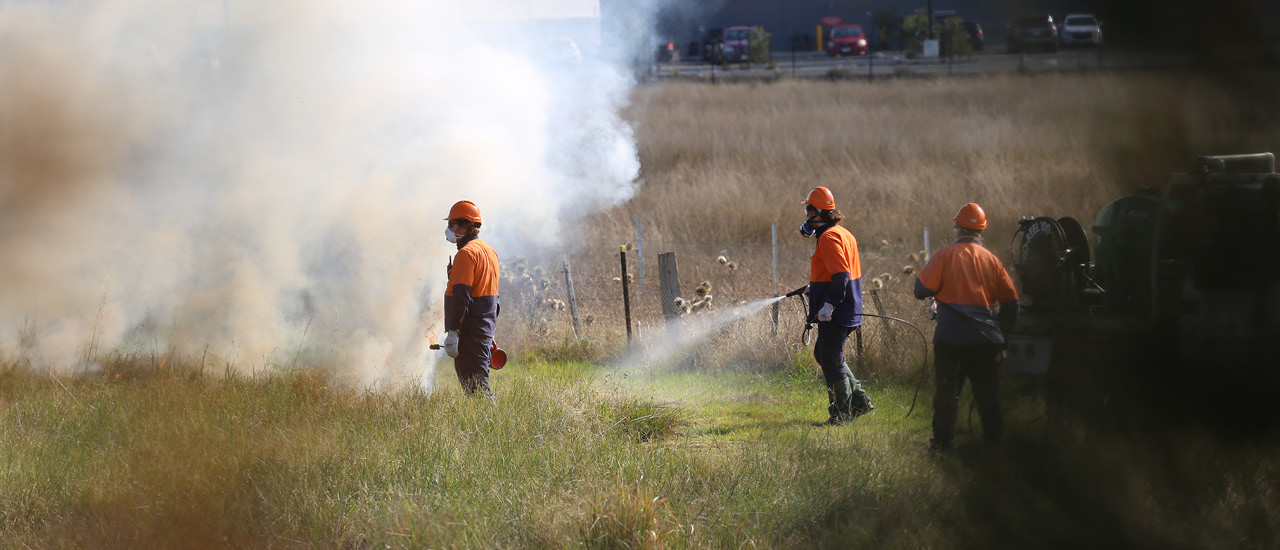An ecological burn was recently completed adjacent to Caroline Springs Station to help improve the habitat for endangered native flora and fauna.
Grasslands next to Caroline Springs Station is home to the critically endangered spiny rice flower and vulnerable striped legless lizard.
Ecological burns are important tools in VicTrack’s conservation and offset management plan for the grassland, explained VicTrack Senior Environmental Project Specialist Renata Pangemanan, who oversaw the burn.
“The purpose of these burns is to improve the quality of this grassland by helping get rid of exotic weeds which can smother and compete with our native species,” Renata said.
“Our contractors will then do follow up work to encourage native species to grow and thrive.”
The ecological burn was undertaken in partnership with the Department of Transport and biodiversity experts.
“These works are all done under an approved burn plan,” Renata said, “Which includes notifying the rail operator, council, the fire department, and also commuters at the station.”
With Victoria’s remnant native grasslands under increasing pressure from urbanisation, preserving this grassland at Caroline Springs, is a key element of VicTrack’s environmental and social governance.
For VicTrack, these activities are an important, albeit lesser-known, part of the work we do as a custodian of Victoria’s rail land.
“I think this type of work definitely goes under the radar. Particularly at a site that looks like this,” she said.
“It doesn't look like much, but little do many people know there is very special flora and fauna that live there.
“Both the spiny rice flower and striped legless lizard are important species that are considered nationally significant. By improving the quality of their habitat we’re able to encourage their survival on VicTrack land.”
VicTrack has worked with the Department of Transport since the station was first being constructed, to ensure the protection and management of the significant vegetation.
In addition to ecological burns, fence repairs, rabbit control, litter removal, additional spiny rice flower plantings, biodiversity surveys and monitoring have been carried out as part of annual biodiversity and land management works.
An ecological burn was recently completed adjacent to Caroline Springs Station to help improve the habitat for endangered native flora and fauna.
Grasslands next to Caroline Springs Station is home to the critically endangered spiny rice flower and vulnerable striped legless lizard.
Ecological burns are important tools in VicTrack’s conservation and offset management plan for the grassland, explained VicTrack Senior Environmental Project Specialist Renata Pangemanan, who oversaw the burn.
“The purpose of these burns is to improve the quality of this grassland by helping get rid of exotic weeds which can smother and compete with our native species,” Renata said.
“Our contractors will then do follow up work to encourage native species to grow and thrive.”
The ecological burn was undertaken in partnership with the Department of Transport and biodiversity experts.
“These works are all done under an approved burn plan,” Renata said, “Which includes notifying the rail operator, council, the fire department, and also commuters at the station.”
With Victoria’s remnant native grasslands under increasing pressure from urbanisation, preserving this grassland at Caroline Springs, is a key element of VicTrack’s environmental and social governance.
For VicTrack, these activities are an important, albeit lesser-known, part of the work we do as a custodian of Victoria’s rail land.
“I think this type of work definitely goes under the radar. Particularly at a site that looks like this,” she said.
“It doesn't look like much, but little do many people know there is very special flora and fauna that live there.
“Both the spiny rice flower and striped legless lizard are important species that are considered nationally significant. By improving the quality of their habitat we’re able to encourage their survival on VicTrack land.”
VicTrack has worked with the Department of Transport since the station was first being constructed, to ensure the protection and management of the significant vegetation.
In addition to ecological burns, fence repairs, rabbit control, litter removal, additional spiny rice flower plantings, biodiversity surveys and monitoring have been carried out as part of annual biodiversity and land management works.



